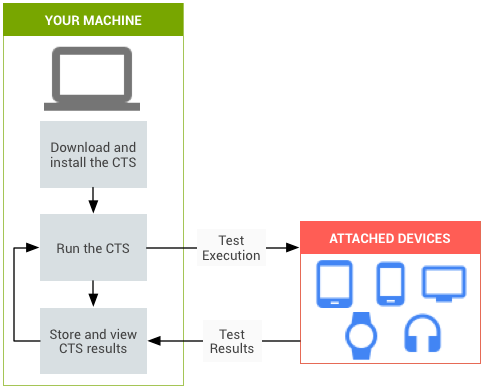مجموعة أدوات اختبار التوافق (CTS) هي مجموعة أدوات اختبار مجانية ومخصّصة للاستخدام التجاري، وتُستخدم للمساعدة في ضمان توافق أجهزتك مع Android. تم تصميم مجموعة اختبارات التوافق ليتم دمجها في سير عملك اليومي، مثلاً من خلال نظام إنشاء مستمر. يتم تشغيل مجموعة اختبارات التوافق على جهاز كمبيوتر مكتبي ويتم تنفيذ الاختبارات مباشرةً على الأجهزة المتصلة أو على محاكي. للحصول على نظرة عامة حول التوافق مع Android، اطّلِع على نظرة عامة حول برنامج التوافق مع Android.

الشكل 1. الاختبار الآلي المتوافق مع CTS
يوضّح الشكل 1 عملية تنفيذ الاختبارات المبرمَجة في مجموعة اختبار التوافق (CTS):
- نزِّل مجموعة اختبار التوافق (CTS) وثبِّتها. تتضمّن هذه الخطوة أيضًا إعداد بيئة الاختبار ومحطة عمل الاختبار والجهاز الذي تختبره أو الجهاز الخاضع للاختبار (DUT).
- تشغيل الاختبارات المبرمَجة في مجموعة اختبارات التوافق (CTS)
- تخزين النتائج ومراجعتها
- تحديد المشاكل وحلّها وإعادة إجراء الاختبارات
استخدِم مجموعة اختبار التوافق (CTS) للكشف عن حالات عدم التوافق مبكرًا، ولضمان استمرار توافق عمليات التنفيذ على Android طوال عملية التطوير.
مكوّنات مجموعة أدوات اختبار التوافق (CTS)
يتضمّن "نظام التوافق" المكوّنات الرئيسية التالية:
- اتحاد التجارة
- تسمح أداة الاختبار وإطار العمل بتنفيذ الاختبارات تلقائيًا.
- الاختبارات المبرمَجة في مجموعة أدوات اختبار التوافق (CTS)
- الاختبارات التي تستخدم إطار عمل Trade Federation ويمكن تشغيلها باستخدام أداة اختبار Trade Federation
- اختبارات CTS Verifier (CTS-V)
- الاختبارات التي يجب إجراؤها يدويًا
- تطبيق CTS Verifier (CTS-V)
- تطبيق يُستخدَم لإجراء اختبارات CTS-V وجمع نتائجها
- حالة الاختبار
يشير إلى اختبار فردي يتم تنفيذه على الجهاز قيد الاختبار. تتم كتابة حالات الاختبار المبرمَجة بلغة Java على شكل اختبارات JUnit وتعبئتها في ملفات APK لنظام Android ليتم تشغيلها على الجهاز المستهدَف.
يمكن أن تكون حالات الاختبار اختبارات وحدة أو اختبارات وظيفية. يختبر اختبار الوحدة أصغر وحدات التعليمات البرمجية ضمن منصة Android. على سبيل المثال، قد يختبر اختبار الوحدة فئة Android واحدة.
يختبر الاختبار الوظيفي مجموعة من الطرق والفئات المستخدَمة لحالة استخدام معيّنة.
- إعداد الاختبار
مجموعة محدّدة من الاختبارات المبرمَجة التي يتم إجراؤها على الجهاز قيد الاختبار إعدادات الاختبار هي ملفات XML تقع في
WORKING_DIRECTORY/cts/tools/cts-tradefed/res/config. تتوفّر إعدادات اختبار تتضمّن جميع حالات الاختبار المبرمَجة، وإعدادات اختبار تتضمّن مجموعة فرعية من حالات الاختبار.- وحدة الاختبار
إعداد اختبار يتألف من مجموعة من حالات الاختبار الخاصة بمجال الميزة نفسه
- خطة الاختبار
إعدادات اختبار تتألف من مجموعة من وحدات الاختبار
تغطية الاختبار
تتضمّن حالات الاختبار المجالات التالية لضمان التوافق:
| المنطقة | الوصف |
|---|---|
| اختبارات التوقيع | يتضمّن كل إصدار من Android ملفات XML تصف تواقيع جميع واجهات برمجة التطبيقات العامة المضمّنة في الإصدار. تحتوي مجموعة أدوات اختبار التوافق على أداة مساعدة للتحقّق من توافق توقيعات واجهات برمجة التطبيقات مع واجهات برمجة التطبيقات المتاحة على الجهاز. يتم تسجيل نتائج التحقّق من التوقيع في ملف XML الخاص بنتائج الاختبار. |
| اختبارات واجهة برمجة التطبيقات على المنصة | اختبِر واجهات برمجة التطبيقات الخاصة بالمنصة (المكتبات الأساسية وإطار عمل تطبيقات Android) كما هو موضّح في فهرس الفئات الخاص بحزمة SDK للتأكّد من صحة واجهة برمجة التطبيقات، بما في ذلك صحة توقيعات الفئات والسمات والطرق، وصحة سلوك الطرق، والاختبارات السلبية لضمان السلوك المتوقّع عند التعامل مع المَعلمات غير الصحيحة. |
| اختبارات Dalvik | وتركز الاختبارات على اختبار تنسيق Dalvik القابل للتنفيذ. |
| نموذج بيانات المنصة | تختبر مجموعة اختبارات التوافق نموذج بيانات النظام الأساسي الأساسي كما هو معروض لمطوّري التطبيقات
من خلال موفّري المحتوى، كما هو موضّح في
حزمة
android.provider لحزمة تطوير البرامج (SDK) (بما في ذلك جهات الاتصال والمتصفحات والإعدادات) |
| المنصات المقصودة | تختبر مجموعة أدوات اختبار التوافق (CTS) نوايا النظام الأساسي، كما هو موضّح في النوايا الشائعة في حزمة تطوير البرامج (SDK). |
| أذونات النظام الأساسي | تختبر مجموعة أدوات اختبار التوافق (CTS) أذونات المنصة الأساسية، كما هو موضّح في
حزمة تطوير البرامج (SDK)
Manifest.permission. |
| مراجع النظام الأساسي | تختبر مجموعة اختبارات التوافق (CTS) التعامل السليم مع أنواع موارد النظام الأساسي الأساسية، كما هو موضّح في نظرة عامة على أنواع الموارد في حزمة تطوير البرامج (SDK). تتضمّن اختبارات CTS اختبارات للقيم البسيطة، والعناصر القابلة للرسم، والصور ذات الأجزاء التسعة، والرسوم المتحركة، والتصاميم، والأنماط والمظاهر، وتحميل الموارد البديلة. |
الخطوات التالية
بعد قراءة هذا المستند، انتقِل إلى إعداد مجموعة اختبار التوافق (CTS).

